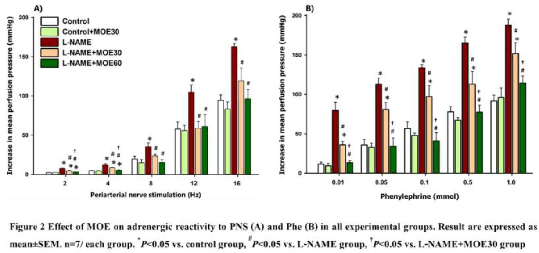| 053P London, UK Pharmacology 2017 |
Effect of Moringa oleifera leaf extract on blood pressure and vascular reactivity to adrenergic stimulation in L-NAME hypertensive rats
Introduction: Sympathetic overactivity resulting in increased total peripheral resistance plays a major role in pathogenesis of hypertension1. Moringa oleifera (MOE) (local name: Marum) is a tropical plant distributed in tropical/subtropical including Thailand. The leaf of Moringa oleifera is used in Thai folk medicine for the treatment of many ailments including cardiac and circulatory problems2. The present study aims to investigate the preventive effect of aqueous leaf extract of MOE on hemodynamic status and adrenergic reactivity in Nω-nitro-L-arginine-methylester (L-NAME) induced hypertensive rats.
Methods: Male Wistar rats (n=7/each group) were administered daily with L-NAME (50 mg/kg/day) in drinking water for three weeks and concurrent treatment with MOE (30 or 60 mg/kg, p.o.) or captopril (5 mg/kg/day, p.o.). At the end of experiment, blood pressure and heart rate (HR) were measured under pentobarbital sodium (60 mg/kg, i.p.) anesthesia. Contractile responses to perivascular nerve stimulation (PNS; 2-16 Hz) and exogenous phenylephrine (Phe; 0.01-1.0 mmol) were tested in isolated mesenteric vascular bed3. Data were expressed as mean ± S.E.M. Statistical analysis was tested by one-way analysis of variance (ANOVA) and followed by Student Newman-Keul's test.
Results: Rats treated with L-NAME had higher BP and HR than the value in control rats. Concurrent treatment with MOE or captopril (5 mg/kg/day) prevented these alterations (Table 1, p<0.05). The hemodynamic disturbances were associated with augmented mesenteric reactivity to adrenergic stimulation including PNS and the selective α1-adrenoceptor agonist in L-NAME rats. Daily MOE-treatment at both low and high doses significantly reduced the reactivity to PNS to the normal levels (Fig.2A, p<0.05). Moreover, oral administration of MOE at doses of 30 and 60 mg/kg resulted in dose-dependent recovery of contractile responses to Phe in L-NAME rats (Fig.2B, p<0.05).
Conclusion: MOE prevents L-NAME induced hypertension in rats, which might involve the suppression of adrenergic hyperactivity. The current results could suggest that MOE might be useful as a dietary supplement against hypertension associated with sympathoexcitation.
References:
1. Koyama T et al.(2010). Hypertens Res 33(5): 485-91.
2. Randriamboavonjy JI et al. (2016). Am J Hypertens 29(7): 873-81.
3. Tangsucharit P et al. (2012). Am J Physiol Regul Integr Comp Physiol 303(11): R1147-56.

Table 1 Effect of MOE on blood pressure and heart rate in L-NAME hypertensive rats
| Parameters | Control | Control+MOE | L-NAME | L-NAME+MOE30 | L-NAME+MOE60 | L-NAME+Cap |
| SBP (mmHg) | 122.9 ± 1.4 | 121.9 ± 1.2 | 193.6 ± 1.6* | 175.7 ± 1.9*,# | 149.0 ± 1.8*,#,† | 161.7 ± 1.2*,# |
| DBP (mmHg) | 83.0 ± 1.6 | 76.9 ± 2.1 | 137.5 ± 2.8* | 110.5 ± 3.0*,# | 90.4 ± 1.4#,† | 114.3 ± 4.7*,# |
| MAP (mmHg) | 95.3 ± 1.1 | 91.8 ± 1.6 | 160.3 ± 1.8* | 134.8 ± 3.6*,# | 109 ± 1.4*,#,† | 126.8 ± 2.7*,# |
| HR (beats/min) | 380.9 ± 3.6 | 395.5 ± 13.4 | 435.0 ± 2.9* | 386.2 ± 9.0# | 339.0 ± 7.3*,#,† | 373.3 ± 3.3# |

